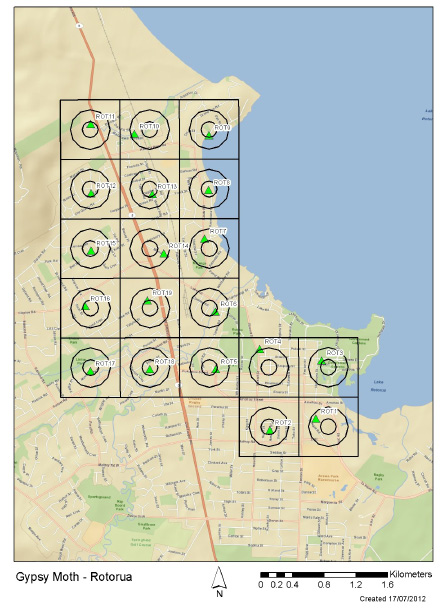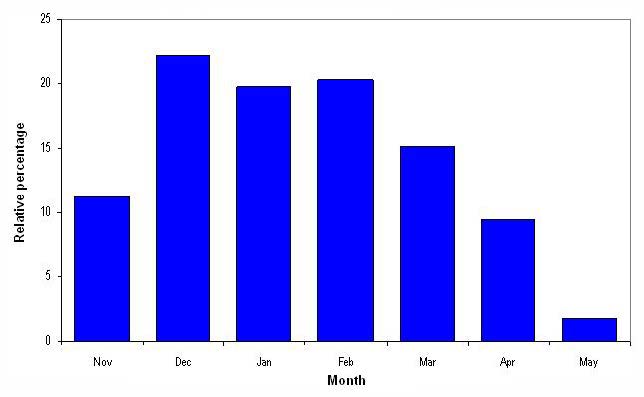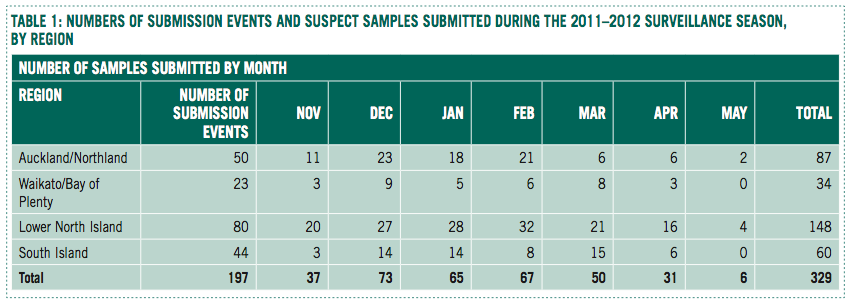PESTS AND DISEASES OF FORESTRY IN NEW ZEALAND
Gypsy moth surveillance programme
From SURVEILLANCE 39 (3) 2012.
Gypsy moth, Lymantria dispar, is a severe defoliator of trees and is described as both an economic and environmental high-impact pest. A major outbreak of gypsy moth in New Zealand could severely impact the horticulture, forest and tourism industries and might also affect the indigenous flora.

It was recognised that high-risk pathways existed for the accidental importation of gypsy moth from other countries, such as international shipping, imported used vehicles and cargo containers. Thus in 1992 the Gypsy Moth Surveillance Programme (GMSP) was developed to provide early warning of gypsy moth incursions, to facilitate eradication and assist with assurance of New Zealand’s status as a country free from gypsy moth. To achieve this the GMSP conducts seasonal monitoring with pheromone traps placed on specific hosts at strategic locations, and a communication programme is carried out using letters, leaflets, cards and reports to promote the biosecurity message about this unwanted species.
AsureQuality has delivered the GMSP, both as part of MPI and for MPI, for almost 20 years.
Trapping
The surveillance season runs from November to May. Pheromone traps are placed in cells making up a grid that is strategically located in areas regarded as high risk for an incursion of gypsy moth. Each cell measures 750 x 750 metres and contains a single pheromone trap for the duration of the surveillance season. The minimum size of each grid is two adjacent cells. In coastal areas a buffer is used to intercept any moths that might fly to land from nearby vessels, and it is only one grid cell in width. The distribution of surveillance locations throughout New Zealand is shown in Figure 1, and an example of a grid overlying a topographical map is shown in Figure 2.

Within each cell, a host tree is selected for trap placement, using a hierarchical ranking of the most suitable host trees, as close to the grid centre as possible. The traps are attached to the trunk or a branch of a suitable host tree (or, rarely, an artificial structure) and are located 1.3–2 metres above the ground. Each trap is a green delta trap with two sticky internal sides and is clearly labelled “Gypsy Moth Trap”, displaying both MPI and AsureQuality logos, and a freephone contact number (Figure 3). Each trap contains a commercial disparlure pheromone lure to attract male gypsy moths. Lures are independently tested and calibrated before each surveillance season and are replaced once during the season, after they have been in the field for 12–14 weeks.
Measures are in place to ensure the programme is robust. New traps are used at the start of each season and all traps and lures are destroyed within two weeks after the end of the season. To avoid sampling bias, gypsy moth traps are not placed in trees bearing any other pheromone traps. Traps are replaced immediately if they are recorded as missing or deemed by the trapper to be significantly damaged.
Trappers attend annual refresher courses on trap-servicing procedures and any changes of procedure.
Results
The gypsy moth trapping season ran from 1 November 2011 until 7 May 2012. The number of traps per run ranged from four to 81 (mean = 41 traps), with a total deployment of 1525 traps. A trap run is a series of traps within a geographic area that are serviced by one trapper and the number of traps in a trap run varies from four to 81. Any suspect moths were submitted to the Scion diagnostic laboratory for identification to family level. Combining the trap run data across the season gave a total of 20 354 trap servicing/inspection events.

In total there were 329 suspect moths submitted. The lower North Island recorded the highest number of submission events (197, or 41 percent of the total) and the highest number of suspect moths (148, or 45 percent) (Table 1).
The largest fraction of submissions (42 percent) were made during December and January (Figure 4, Table 1). There appears to be a slight north–south trend in submission events, with Auckland/Northland and Waikato/Bay of Plenty reaching peaks of submission events in December 2011 while the lower North Island increased steadily, reaching a peak in February 2012 at 32, and the South Island peaked in March 2012, at 15 submission events. However, this division is slightly arbitrary as the South Island recorded 14 submissions events in both December 2011 and January 2012.
No gypsy moths were found during the entire season. Moth specimens submitted were mainly of the families Noctuidae and Tortricidae. No suspect samples were forwarded for taxonomic determination as a result of calls made to the exotic pest and disease hotline.


The 2011–2012 surveillance season was a success in terms of meeting the programme’s objectives. No new incursions of gypsy moth were recorded. A large number of samples were collected and submitted for taxonomic determination and the samples were obtained by a scientifically robust grid-based sampling process.
Rory MacLellan
Senior Adviser
Surveillance and Incursion Investigation
Ministry for Primary Industries



